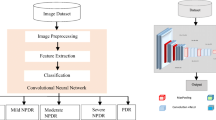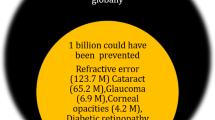Abstract
Hyperreflective foci (HF) reflects inflammatory responses for fundus diseases such as diabetic macular edema (DME), retina vein occlusion (RVO), and central serous chorioretinopathy (CSC). Shown as high contrast and reflectivity in optical coherence tomography (OCT) images, automatic segmentation of HF in OCT images is helpful for the prognosis of fundus diseases. Previous traditional methods were time-consuming and required high computing power. Hence, we proposed a lightweight network to segment HF (with a speed of 57 ms per OCT image, at least 150 ms faster than other methods). Our framework consists of two stages: an NLM filter and patch-based split to preprocess images and a lightweight DBR neural network to segment HF automatically. Experimental results from 3000 OCT images of 300 patients (100 DME,100 RVO, and 100 CSC) revealed that our method achieved HF segmentation successfully. The DBR network had the area under curves dice similarity coefficient (DSC) of 83.65%, 76.43%, and 82.20% in segmenting HF in DME, RVO, and CSC on the test cohort respectively. Our DBR network achieves at least 5% higher DSC than previous methods. HF in DME was more easily segmented compared with the other two types. In addition, our DBR network is universally applicable to clinical practice with the ability to segment HF in a wide range of fundus diseases.








Similar content being viewed by others
Availability of Data and Materials
All data included in this study are available upon reasonable request by contact with the corresponding author.
References
Romano F, Arrigo A, MacLaren RE, Charbel Issa P, Birtel J, Bandello F, Battaglia Parodi M: HYPERREFLECTIVE FOCI AS A PATHOGENETIC BIOMARKER IN CHOROIDEREMIA. Retina. 40(8):1634-1640, 2020 ;
Pilotto E, Miante S, Torresin T, Puthenparampil M, Frizziero L, Federle L, Gallo P, Midena E.: Hyperreflective Foci in the Retina of Active Relapse-Onset Multiple Sclerosis. Ophthalmology. 127(12):1774-1776, 2020
Schreur V, de Breuk A, Venhuizen FG, Sánchez CI, Tack CJ, Klevering BJ, de Jong EK, Hoyng CB: RETINAL HYPERREFLECTIVE FOCI IN TYPE 1 DIABETES MELLITUS. Retina 8:1565-1573,2020
Yoshitake T, Murakami T, Suzuma K, Dodo Y, Fujimoto M, Tsujikawa A: Hyperreflective Foci in the Outer Retinal Layers as a Predictor of the Functional Efficacy of Ranibizumab for Diabetic Macular Edema. Sci Rep 10(1):873, 2020
Kim YH, Oh J: Hyperreflective foci in the choroid of normal eyes. Graefes Arch Clin Exp Ophthalmol 3:759-769, 2022
Hsia Y, Yang CH, Hsieh YT, Yang CM, Ho TC, Lai TT: Hyperreflective foci in predicting the treatment outcome of antivascular endothelial growth factor in neovascular age-related macular degeneration. Graefes Arch Clin Exp Ophthalmol 2:273-280, 2020
Deb AK, Sarkar S. Commentary: Hyperreflective foci on optical coherence tomography and their clinical implications in diabetic macular edema. Indian J Ophthalmol 69(11):3206-3207, 2021
Atiskova Y, Rassuli R, Koehn AF, Golsari A, Wagenfeld L, du Moulin M, Muschol N, Dulz S: Retinal hyperreflective foci in Fabry disease. Orphanet J Rare Dis 14(1):296, 2019
Huang CH, Yang CH, Hsieh YT, Yang CM, Ho TC, Lai TT: Hyperreflective foci in predicting the treatment outcomes of diabetic macular edema after anti-vascular endothelial growth factor therapy 11:5992-5103, 2021
Mo B, Zhou HY, Jiao X, Zhang F. Evaluation of hyperreflective foci as a prognostic factor of visual outcome in retinal vein occlusion. Int J Ophthalmol 10: 605-612, 2017
Hajdu D, Told R, Angeli O, Weigert G, Pollreisz A, Schmidt-Erfurth U, Sacu S. Identification of microvascular and morphological alterations in eyes with central retinal non-perfusion. PLoS One 15: 11-15, 2020
Qin HF, Shi FJ, Zhang CY, Luo DW, Qin SY, Wu J, Xie H, Zhang JT, Qiu QH, Liu K, Xu GT, Xu GX, Zhang JF. Anti-VEGF reduces inflammatory features in macular edema secondary to retinal vein occlusion. Int J Ophthalmol 15:1296-1304, 2022
Hanumunthadu D, Van Dijk EHC, Gangakhedkar S, Goud A, Cheung CMG, Cherfan D, Sarvaiya C, Banker A, Meyerle C, Boon CJ, Singh R, Wu L, Chhablani J. Gender variation in central serous chorioretinopathy. Eye (Lond) 11:1703-1709, 2018.
Han L, de Carvalho JRL Jr, Parmann R, Tezel TH, Chang S, Sharma T, Sparrow JR: Central Serous Chorioretinopathy Analyzed by Multimodal Imaging. Transl Vis Sci Technol 10: 9-15, 2021
Borrelli E, Zuccaro B, Zucchiatti I, Parravano M, Querques L, Costanzo E, Sacconi R, Prascina F, Scarinci F, Bandello F, Querques G. Optical Coherence Tomography Parameters as Predictors of Treatment Response to Eplerenone in Central Serous Chorioretinopathy. J Clin Med 8: 1265-1271, 2019
Mitsch C, Lammer J, Karst S, Scholda C, Pablik E, Schmidt-Erfurth UM. Systematic ultrastructural comparison of swept-source and full-depth spectral domain optical coherence tomography imaging of diabetic macular oedema. Br J Ophthalmol 7:868-873,2022
Grondin C, Au A, Wang D, Gunnemann F, Tran K, Hilely A, Sadda S, Sarraf D. Identification and Characterization of Epivascular Glia Using En Face Optical Coherence Tomography. Am J Ophthalmo 9:108-119, 2021
Lammer J, Bolz M, Baumann B: Detection and analysis of hard exudates by polarization-sensitive optical coherence tomography in patients with diabetic maculopathy,Invest Ophthalmol Vis Sci 12:1564-1571, 2014
Okuwobi IP, Ji Z, Fan W, Yuan S, Bekalo L, Chen Q: Automated Quantification of Hyperreflective Foci in SD-OCT With Diabetic Retinopathy. IEEE J Biomed Health Inform 24:1125-1136, 2020
Yu C, Xie S, Niu S, Ji Z, Fan W, Yuan S, Liu Q, Chen Q: Hyper-reflective foci segmentation in SD-OCT retinal images with diabetic retinopathy using deep convolutional neural networks. Med Phys 11:4502-4519, 2019
Mehdizadeh M, MacNish C, Xiao D, Alonso-Caneiro D, Kugelman J, Bennamoun M. Deep feature loss to denoise OCT images using deep neural networks. J Biomed Opt 4:13-19, 2021
Gómez-Valverde JJ, Sinz C, Rank EA, Chen Z, Santos A, Drexler W, Ledesma-Carbayo MJ. Adaptive compounding speckle-noise-reduction filter for optical coherence tomography images. J Biomed Opt 6: 542-550, 2021
Zhou Q, Guo J, Ding M, Zhang X. Guided filtering-based nonlocal means despeckling of optical coherence tomography images. Opt Lett 19: 5600-5603, 2020
Li C, Qiu Z, Cao X, Chen Z, Gao H, Hua Z. Hybrid Dilated Convolution with Multi-Scale Residual Fusion Network for Hyperspectral Image Classification. Micromachines (Basel) 5: 522-530, 2021
Zhang Y, Tian Y, Kong Y, Zhong B, Fu Y. Residual Dense Network for Image Restoration. IEEE Trans Pattern Anal Mach Intell 7: 2480-2495, 2021
Zou K H, Warfield S K, Bharatha A, et al. Statistical validation of image segmentation quality based on a spatial overlap index1: scientific reports[J]. Academic radiology, 2004, 11(2): 178-189.
Xie S, Okuwobi IP, Li M, Zhang Y, Yuan S, Chen Q. Fast and Automated Hyperreflective Foci Segmentation Based on Image Enhancement and Improved 3D U-Net in SD-OCT Volumes with Diabetic Retinopathy. Transl Vis Sci Technol 4:9-21, 2020
Stankiewicz A, Marciniak T, Dabrowski A, Stopa M, Marciniak E, Obara B. Segmentation of Preretinal Space in Optical Coherence Tomography Images Using Deep Neural Networks. Sensors (Basel) 11:21-29, 2021
Song X, Xu Q, Li H, Fan Q, Zheng Y, Zhang Q, Chu C, Zhang Z, Yuan C, Ning M, Bian C, Ma K, Qu Y. Automatic quantification of retinal photoreceptor integrity to predict persistent disease activity in neovascular age-related macular degeneration using deep learning. Front Neurosci 8:16-24, 2022
Shen C, Liu L, Zhu L, Kang J, Wang N, Shao L. High-Throughput in situ Root Image Segmentation Based on the Improved DeepLabv3+ Method. Front Plant Sci 11. 135-147, 2021
Bengio Y, Grandvalet Y. No unbiased estimator of the variance of k-fold cross-validation[J]. Advances in Neural Information Processing Systems, 2003, 16.
Gribbon K T, Bailey D G. A novel approach to real-time bilinear interpolation[C]//Proceedings. DELTA 2004. Second IEEE international workshop on electronic design, test and applications. IEEE, 2004: 126-131.
Ronneberger O, Fischer P, Brox T. U-net: Convolutional networks for biomedical image segmentation[C]//International Conference on Medical image computing and computer-assisted intervention. Springer, Cham, 2015: 234–241.
Long J, Shelhamer E, Darrell T. Fully convolutional networks for semantic segmentation[C]//Proceedings of the IEEE conference on computer vision and pattern recognition. 2015: 3431–3440.
Zhou Z, Rahman Siddiquee M M, Tajbakhsh N, et al. Unet++: A nested u-net architecture for medical image segmentation[M]//Deep learning in medical image analysis and multimodal learning for clinical decision support. Springer, Cham, 2018: 3-11.
Roy A G, Conjeti S, Karri S P K, et al. ReLayNet: retinal layer and fluid segmentation of macular optical coherence tomography using fully convolutional networks[J]. Biomedical optics express, 2017, 8(8): 3627-3642.
Florian L C, Adam S H. Rethinking atrous convolution for semantic image segmentation[C]//Conference on computer vision and pattern recognition (CVPR). IEEE/CVF. 2017, 6.
Yao C, Wang M, Zhu W, et al. Joint Segmentation of Multi-Class Hyper-Reflective Foci in Retinal Optical Coherence Tomography Images[J]. IEEE Transactions on Biomedical Engineering, 2021, 69(4): 1349-1358.
Funding
This study is supported by the National Natural Science Foundation of China (Grant No. 82201246&82171100), Medical-Engineering Funding of Shanghai Jiao Tong University (Grant No. ZH2018QNA24), and Shanghai Medical Guidance Project (Grant No.19411961800). The sponsors or funding organizations had no role in the design or conduct of this research.
Author information
Authors and Affiliations
Contributions
Jin Wei, Suqin Yu, and Yupeng Xu planned the study. Yupeng Xu and Yuchen Du collected the data; Jin Wei and Suqin Yu performed statistical analyses and drafted the first version of the manuscript. Jin Wei and Yupeng Xu preprocessed the data. Yupeng Xu, Kun Liu, and Xun Xu contributed to the interpretation of the data and revised the manuscript critically for important intellectual content. All authors approved the final manuscript and agreed to be accountable for all aspects of the work.
Corresponding author
Ethics declarations
Ethics Approval
This study protocol was approved by the Institutional Review Board and Ethics Committee of Shanghai General Hospital and complied with the tenets of the Declaration of Helsinki (IRB No.: 2022SQ066).
Consent to Participate
Written informed consent was obtained from individuals who participated in this study.
Consent for Publication
The authors agree to publication in the Journal of Digital Imaging.
Competing Interests
The authors declare no competing interests.
Additional information
Publisher's Note
Springer Nature remains neutral with regard to jurisdictional claims in published maps and institutional affiliations.
Rights and permissions
Springer Nature or its licensor (e.g. a society or other partner) holds exclusive rights to this article under a publishing agreement with the author(s) or other rightsholder(s); author self-archiving of the accepted manuscript version of this article is solely governed by the terms of such publishing agreement and applicable law.
About this article
Cite this article
Wei, J., Yu, S., Du, Y. et al. Automatic Segmentation of Hyperreflective Foci in OCT Images Based on Lightweight DBR Network. J Digit Imaging 36, 1148–1157 (2023). https://doi.org/10.1007/s10278-023-00786-0
Received:
Revised:
Accepted:
Published:
Issue Date:
DOI: https://doi.org/10.1007/s10278-023-00786-0




